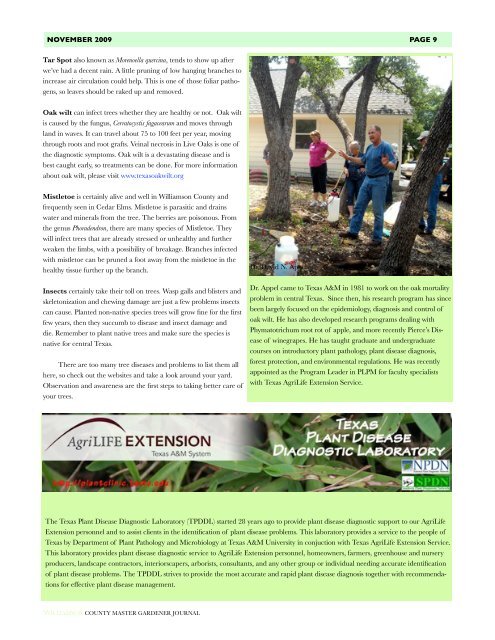November 2009 Journal - Texas Master Gardeners Association
November 2009 Journal - Texas Master Gardeners Association
November 2009 Journal - Texas Master Gardeners Association
You also want an ePaper? Increase the reach of your titles
YUMPU automatically turns print PDFs into web optimized ePapers that Google loves.
NOVEMBER <strong>2009</strong> PAGE 9<br />
Tar Spot also known as Morenoella quercina, tends to show up after<br />
we’ve had a decent rain. A little pruning of low hanging branches to<br />
increase air circulation could help. This is one of those foliar pathogens,<br />
so leaves should be raked up and removed.<br />
Oak wilt can infect trees whether they are healthy or not. Oak wilt<br />
is caused by the fungus, Cerratocystis fagacearum and moves through<br />
land in waves. It can travel about 75 to 100 feet per year, moving<br />
through roots and root grafts. Veinal necrosis in Live Oaks is one of<br />
the diagnostic symptoms. Oak wilt is a devastating disease and is<br />
best caught early, so treatments can be done. For more information<br />
about oak wilt, please visit www.texasoakwilt.org<br />
Mistletoe is certainly alive and well in Williamson County and<br />
frequently seen in Cedar Elms. Mistletoe is parasitic and drains<br />
water and minerals from the tree. The berries are poisonous. From<br />
the genus Phoradendron, there are many species of Mistletoe. They<br />
will infect trees that are already stressed or unhealthy and further<br />
weaken the limbs, with a possibility of breakage. Branches infected<br />
with mistletoe can be pruned a foot away from the mistletoe in the<br />
healthy tissue further up the branch.<br />
Insects certainly take their toll on trees. Wasp galls and blisters and<br />
skeletonization and chewing damage are just a few problems insects<br />
can cause. Planted non-native species trees will grow fine for the first<br />
few years, then they succumb to disease and insect damage and<br />
die. Remember to plant native trees and make sure the species is<br />
native for central <strong>Texas</strong>.<br />
There are too many tree diseases and problems to list them all<br />
here, so check out the websites and take a look around your yard.<br />
Observation and awareness are the first steps to taking better care of<br />
your trees.<br />
Dr. David N. Appel<br />
Dr. Appel came to <strong>Texas</strong> A&M in 1981 to work on the oak mortality<br />
problem in central <strong>Texas</strong>. Since then, his research program has since<br />
been largely focused on the epidemiology, diagnosis and control of<br />
oak wilt. He has also developed research programs dealing with<br />
Phymatotrichum root rot of apple, and more recently Pierce’s Disease<br />
of winegrapes. He has taught graduate and undergraduate<br />
courses on introductory plant pathology, plant disease diagnosis,<br />
forest protection, and environmental regulations. He was recently<br />
appointed as the Program Leader in PLPM for faculty specialists<br />
with <strong>Texas</strong> AgriLife Extension Service.<br />
The <strong>Texas</strong> Plant Disease Diagnostic Laboratory (TPDDL) started 28 years ago to provide plant disease diagnostic support to our AgriLife<br />
Extension personnel and to assist clients in the identification of plant disease problems. This laboratory provides a service to the people of<br />
<strong>Texas</strong> by Department of Plant Pathology and Microbiology at <strong>Texas</strong> A&M University in conjuction with <strong>Texas</strong> AgriLife Extension Service.<br />
This laboratory provides plant disease diagnostic service to AgriLife Extension personnel, homeowners, farmers, greenhouse and nursery<br />
producers, landscape contractors, interiorscapers, arborists, consultants, and any other group or individual needing accurate identification<br />
of plant disease problems. The TPDDL strives to provide the most accurate and rapid plant disease diagnosis together with recommendations<br />
for effective plant disease management.<br />
WILLIAMSON COUNTY MASTER GARDENER JOURNAL














